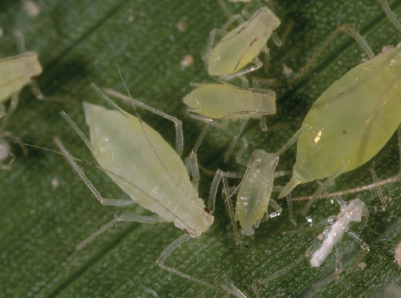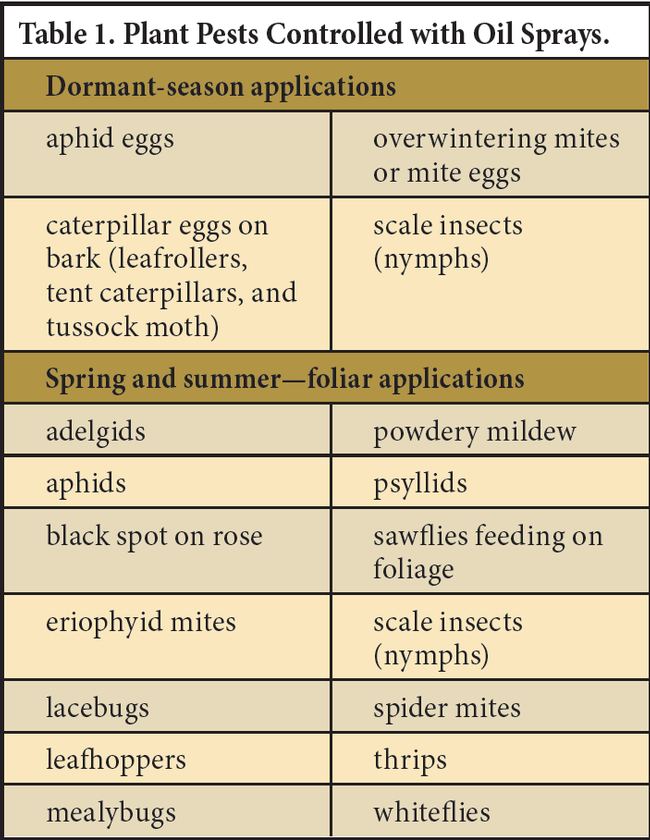[From March 2014 issue of the Retail Nursery and Garden Center IPM News.]
Oils are often the best pesticide choice for controlling soft-bodied insects and mites, as well as several foliar diseases including powdery mildew in the garden and landscape (Table 1). They can be safely used on both woody and

Oils used for managing pests on plants are most often called horticultural oils[1]. These oils may be derived from petroleum sources and are sometimes called mineral oil, narrow range oil, or superior oil. Other pesticidal oils may be made from plant seeds, such as canola oil, neem oil, jojoba oil, or cottonseed oil.
How They Work
The primary way oils kill insects and mites is the same—by suffocation. Insects breathe through structures called spiracles. Oils block spiracles, reducing the availability of oxygen and interfering with various metabolic processes. When applied to insect or mite eggs, oils can penetrate the shells and kill the developing embryo. Oils may also act as a repellent in some cases, especially with some of the plant-based oils, and some oils, such as neem oil, have anti-feeding properties.
Because oils kill by suffocating insects, apply the product so it completely covers the target pests. Be sure to treat both the underside and topside of leaves, buds and shoots, and all locations where the insects or mites may be located. Spraying during the dormant season, when leaves are off trees or shrubs, is recommended for scales and some other insects because it is easier to get good coverage on leafless trees.
Usually, immature stages of insects are most susceptible, especially with scale insects, mealybugs, and true bugs. Insects that feed within curled leaves, such as leaf-curling aphids, leaf miners, or gall-forming species, are protected from oil sprays and not well controlled. Oils don't control caterpillars, beetles, grasshoppers, and boring insects, with the exception of some caterpillars in the egg stage.
In some cases, oils improve the efficacy of other pesticides. For instance, applications of both codling moth granulosis virus (Cyd-X) and spinosad are more effective against codling moth when 1% oil is added to the spray. Addition of 1% oil to copper ammonium complex or copper soap sprays improves their effectiveness against peach leaf curl.
For managing certain foliar diseases such as powdery mildew, oils can act as both a preventive and a curative fungicide, smothering fungal growth and inhibiting spore production. In many cases, oils are more effective than standard fungicides in reducing existing powdery mildew infections.

Tips to Know
All oils now sold as pesticides are highly refined and can be used safely on most plants throughout most of the year, unless plants are water-stressed. Exceptions include maples, walnuts, and smoke tree. Redbud, juniper, cedar, spruce, and Douglas-fir are also sometimes injured. Oil injury to these plants usually involves discoloration of leaves or needles.
Many plants are sensitive to oil damage when water-stressed, so be sure plants have been adequately irrigated before application. Most oil labels also warn against applying oils when temperatures are below freezing or above 90°F. Oils shouldn't be applied in combination with sulfur, or within 30 days of a sulfur application, because of potential phytotoxicity. As with any pesticide, always check product labels for precautions or other restrictions before applying.
[1] The food grade plant extract oils (rosemary, thyme, clove, cinnamon, etc.) function as antifeedants, repellents, or neurotoxins and thus affect pests differently than the traditional petroleum or plant/seed-based horticultural oils discussed here.
This article was originally published in the March 2014 issue of the Retail Nursery and Garden Center IPM News. See this and other articles at http://www.ipm.ucdavis.edu/RETAIL/retail-newsletter.html .